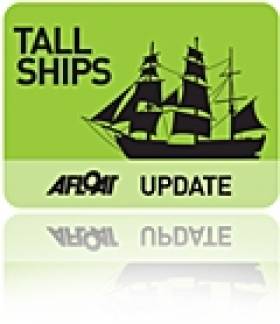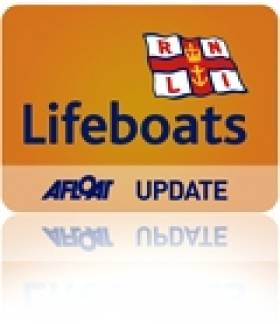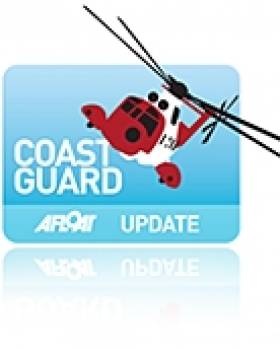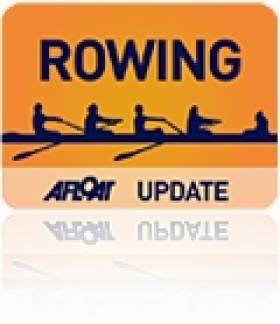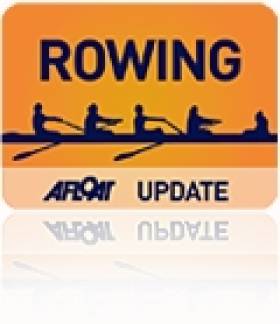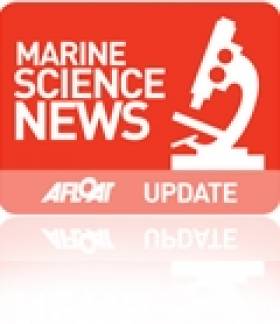Displaying items by tag: Belfast
Portora Top Rankings at Lagan's Head of the River
#ROWING: Portora’s men’s junior 18 quadruple scull was the fastest crew in the first head of the Lagan Head of the River on Saturday. The fastest single sculler on the day was a junior – Dylan Mitchell of Bann outpaced intermediate Sam McKeown of Portadown. Senior sculler Ruth Morris of Trinity was the fastest woman, while the Queen's novice eight was the fastest women's crew.
Lagan Head of the River, Belfast, Saturday (2,700m)
Head One:
Overall: 1 Portora men’s junior 18A quadruple sculls 10 min 10.3 sec, 2 Belfast BC mens’ senior double sculls 10:46.6, 3 Methodist A men’s junior 16 coxed quad 11:06.5, 4 Bann jun 18A coxed quad 11:06.5, 5 Commercial club one coxed four 11:07.6, 6 Portora jun 16 coxed four 11:20.0.
Men
Eight – Novice: Trinity 11:27.7.
Four – Club One, coxed: Commercial 11:07.6. Novice, coxed: RBAI 12:14.1. Jun 18A: Coleraine AI 11:24.1. Jun 16, coxed: Portora 11:10.8.
Pair – Sen: Belfast RC A 12:11.5. Jun 18: Methodist 12:05.9.
Sculling
Quadruple – Club One, coxed: RBAI 11:21.2. Jun 18A: Portora 10:10.3; Jun 18A, coxed: Bann 11:06.5. Jun 16, coxed: Methodist A 10:53.6
Double – Senior: Belfast BC 10:46.6. Club One: Methodist 11:18.7. Jun 18A: Bann 11:31.6. Jun 16: Methodist 12:05.2.
Single – Senior: Trinity (J Dover) 12:23.1. Inter: Portadown (S McKeown) 11:55.0. Club One: Trinity (J Norton) 12:03.1. Jun 18A: Bann (D Mitchell) 11:52.5.
Women
Eight – Novice: Queen’s A 12:24.6.
Four – Inter, coxed: Belfast RC 12:45.8. Club One, coxed: Trinity 12:35.6. Jun 18: Methodist 12:17.8. Jun 16, coxed: Portora 12:15.4.
Pair – Senior: Methodist 13:06.4. Jun 18A: Portora 12:49.2.
Sculling,
Quadruple – Novice, coxed: Belfast BC 13:57.2. Jun 18A: Bann 11:27.8. Jun 16, coxed: Portora 12:44.9.
Double – Club One: Queen’s 12:53.8. Jun 18A: Neptune 12:40.7.
Single – Senior: Trinity (R Morris) 12:27.4. Inter: Belfast BC (S Quinn) 13:11.4. Club One: Queen’s (R Maguire) 13:46.8. Jun 18A: Bann (E Barry) 13:39.9.
| POSITION |
|---|
| CREW |
| NUMBER Club Class Cox/Steerer Time % of winning |
| time Comments |
| 1 101 Portora MJ18A 4X- E. Gebler 10:10.3 100.00 |
| 2 105 Belfast BC MS 2X M. McKibbin 10:46.6 105.95 |
| 3 122 Methodist A MJ16 4X+ J. Thompson 10:53.6 107.11 |
| 4 121 Bann MJ18A 4X+ C. Bell 11:06.5 109.22 |
| 5 112 Commercial MC1 4+ R. Keogh 11:07.6 109.40 |
| 6 147 Portora MJ16 4+ M. Woodhouse 11:10.8 109.93 |
| 7 115 Methodist MC1 2X E. Magill 11:18.7 111.21 |
| 8 128 Bann MJ16 4X+ F. Lestas 11:20.0 111.43 |
| 9 124 Commercial MJ16 4X+ R. Keogh 11:20.7 111.55 |
| 10 111 RBAI MC1 4X+ R. Hulatt 11:21.2 111.62 |
| 11 109 CAI MJ18A 4- L. Beach 11:24.1 112.09 |
| 12 102 Methodist MJ18A 4X- E. Sweeny 11:24.9 112.23 |
| 13 131 DUBC MN 8+ D. O'Carroll 11:27.7 112.70 |
| 14 154 Bann WJ18A 4X- R. Meenagh 11:27.8 112.71 |
| 15 103 CAI MJ18A 4X- J. Gregg 11:29.7 113.01 |
| 16 120 Bann MJ18A 2X T. Davidson 11:31.6 113.33 |
| 17 142 Commercial MJ15 8+ T. Cahill 11:35.0 113.89 |
| 18 114 CAI MC1 2X O. Gage 11:39.2 114.57 |
| 19 110 Commercial MC1 4X+ R. Keogh 11:42.4 115.09 |
| 20 157 Neptune MJ15 4X+ J. Butler 11:51.2 116.54 |
| 21 141 Bann MJ18A 1X D. Mitchell 11:52.5 116.75 |
| 22 152 Portora WJ18A 4X- L. Mulligan 11:53.1 116.86 |
| 23 133 Portadown MI 1X S. McKeown 11:55.0 117.16 |
| 24 135 Portora MI 1X E. Murray 11:59.3 117.86 |
| 25 153 Methodist WJ18A 4X- L. Bell 12:00.4 118.04 |
| 26 163 DUBC MC1 1X J. Norton 12:03.1 118.48 |
| 27 113 DUBC MC1 2X R. Sugrue 12:03.1 118.49 |
| 28 137 Belfast BC MJ18A 1X A. Murray 12:04.0 118.64 |
| 29 145 Methodist MJ16 2X X. Young 12:05.2 118.83 |
| 30 108 Methodist MJ18A 2- M. Taylor 12:05.9 118.94 |
| 31 164 DUBC MC1 1X N. Rawlinson 12:06.1 118.97 |
| 32 106 Belfast RC A MS 2- I. Crawford 12:11.5 119.86 |
| 33 144 RBAI MN 4+ D. Simpson 12:14.1 120.28 |
| 34 107 Belfast RC B MS 2- T. McCaughtry 12:14.2 120.31 |
| 35 198 Portora WJ16 4+ S. Dolan 12:15.4 120.50 |
| 36 149 Methodist WJ18A 4- O. Andress 12:17.8 120.89 |
| 37 127 Neptune MJ16 4X+ M. Hartigan 12:19.7 121.21 |
| 38 155 Belfast RC WJ18A 4X- C. Coulter 12:22.7 121.70 |
| 39 116 DUBC MS 1X J. Dover 12:23.1 121.77 |
| 40 162 DUBC MC1 1X B. Maguire 12:23.4 121.81 |
| 41 150 Belfast BC MME 2- C. Hunter 12:23.9 121.89 |
| 42 208 QUBLBC A WN 8+ G. Canham 12:24.6 122.01 |
| 43 158 Methodist MJ15 4X+ J. Kelly 12:26.2 122.27 |
| 44 139 RBAI MJ18A 1X N. Reid 12:26.9 122.38 |
| 45 184 DULBC WS 1X R. Morris 12:27.4 122.48 |
| 46 168 DULBC WC1 4+ K. Paterson 12:35.6 123.82 |
| 47 129 Carlow MME 4+ P. Doyle 12:37.0 124.05 |
| 48 177 Methodist MJ15 8X A. Kashyap 12:37.4 124.11 |
| 49 170 Neptune WJ18A 2X C. Ferrick 12:40.7 124.65 |
| 50 212 Portora A WJ15 8+ J. Willis 12:40.8 124.67 |
| 51 182 Portora MME 1X G. Murphy 12:42.0 124.86 |
| 52 197 Portora WJ16 4X+ C. McClean 12:44.9 125.34 |
| 53 119 RBAI MJ18A 2X M. Gaston 12:45.1 125.37 |
| 54 151 Belfast RC WI 4+ B. Kelly 12:45.8 125.49 |
| 55 195 Carlow WMC 4X- K. Wall-Scully 12:48.2 125.88 |
| 56 171 Portora WJ18A 2- E. Glover 12:49.2 126.03 |
| 57 140 RBAI MJ18A 1X H. Heatherington 12:49.2 126.04 |
| POSITION CREW |
| NUMBER |
| Club Class Cox/Steerer Time |
| % of winning |
| time |
| Comments |
| 58 138 Belfast RC MJ18A 1X J. Jordan 12:50.3 126.22 |
| 59 132 Bann MI 1X C. Mitchell 12:51.6 126.43 |
| 60 156 Neptune WJ18A 4X- A. O'Mahoney 12:52.6 126.60 |
| 61 165 QUBLBC A WC1 4+ A. Murdock 12:53.0 126.66 |
| 62 185 DULBC WS 1X S. O'Brien 12:53.3 126.72 |
| 63 202 QUBLBC WC1 2X A. Green 12:53.8 126.79 |
| 64 193 Belfast BC MMG 2X D. Gray 12:56.5 127.24 |
| 65 160 Belfast RC MC1 1X A. Kernohan 12:57.5 127.40 |
| 66 183 C of Derry MME 1X G. D'Urso 12:59.9 127.79 |
| 67 148 CAI MJ16 4+ A. Scott 13:02.5 128.22 |
| 68 169 QUBLBC B WC1 4+ A. DeBaroid 13:03.6 128.40 |
| 69 179 Methodist WS 2- L. McIntyre 13:06.4 128.86 |
| 70 143 Portora MJ15 8+ D. Robinson 13:07.9 129.11 |
| 71 130 OCBC MMG 4+ M. Cusack 13:07.9 129.11 |
| 72 172 Bann WJ18A 2X A. O'Donovan 13:08.4 129.19 |
| 73 189 Belfast BC WI 1X S. Quinn 13:11.4 129.68 |
| 74 188 Methodist WI 1X C. Deyermond 13:11.7 129.72 |
| 75 134 Portadown MI 1X A. Laivins 13:13.2 129.97 |
| 76 178 Portora MJ14 4X+ L. Rafferty 13:13.3 129.99 |
| 77 125 Methodist B MJ16 4X+ J. Ramsey 13:21.7 131.37 |
| 78 203 Belfast BC WC1 1X O. Blundell 13:27.9 132.39 |
| 79 146 Commercial MJ16 2X R. Keogh 13:31.7 133.00 |
| 80 123 CAI MJ16 4X+ J. Grant 13:31.9 133.03 |
| 81 167 Belfast RC WC1 4+ S. Smith 13:39.0 134.20 |
| 82 173 Bann WJ18A 1X E. Barry 13:39.9 134.35 |
| 83 205 LVBC MME 2X D. O'Hara 13:40.6 134.47 |
| 84 204 QUBLBC WC1 1X R. Maguire 13:46.8 135.47 |
| 85 206 DULBC A WN 8+ M. Devlin 13:49.4 135.90 |
| 86 180 Lagan MMC 1X P. Cross 13:51.8 136.30 |
| 87 210 Belfast BC WN 4X+ J. Malloy 13:57.2 137.18 |
| 88 166 Belfast BC WC1 4+ R. Cullen 13:58.5 137.40 |
| 89 181 LVBC MME 1X PJ Keown 14:16.2 140.30 |
| 90 207 DULBC B WN 8+ R. Cusack 14:20.1 140.93 |
| 91 117 Neptune B MJ18A 2X P. Dunn 14:20.2 140.96 |
| 92 175 Belfast RC WJ18A 4X+ B. McCaughtry 14:20.4 140.98 |
| 93 211 QUBLBC WN 4X+ E. Armstrong 14:25.1 141.75 |
| 94 214 Carlow WJ14 4X+ M. Nolan 14:35.3 143.43 |
| 95 159 Commercial MJ15 4X+ S. Cooke 14:49.6 145.77 |
| 96 126 Portadown MJ16 4X+ P. Waterson 14:53.1 146.34 |
| 97 213 Portora B WJ15 8+ R. Ballintine 14:55.9 146.80 |
| 98 196 Portadown WJ16 4X+ W. Pinkerton 15:09.8 149.08 |
| 99 209 QUBLBC B WN 8+ C. McCausland 15:20.9 150.90 |
| 100 194 Belfast RC WMC 4+ D. Kelly 15:24.6 151.50 |
| 101 190 Methodist WI 1X J. Copeland 15:45.9 155.01 |
| 102 215 Portora WJ14 4X+ E. Mooney 15:48.7 155.45 |
| 103 199 Carlow WJ16 2X A. Doyle 15:53.1 156.17 |
| 104 200 Portadown WMC 1X S. Laivina 16:02.1 157.65 |
Belfast Expects 80 Tall Ships For 2015 Races & 500,000 Spectators
#Tallships – From 2 to 5 July 2015 tall ships from across the world will anchor in Belfast port for the start of The Tall Ships Races 2015.
Organised by Sail Training International, The Tall Ships Races will be welcomed by the annual Lidl Belfast Titanic Maritime Festival. This is the third time that Belfast has hosted the races, having previously welcomed the ships in 1991 and 2009.
Both previous visits were incredibly popular; in 2009 around 800,000 spectators came to the four-day event, when a flotilla of 40 ships berthed along the city's quays.
In 2015 Belfast hopes to attract 500,000 people, with another 500,000 watching the ships arrive and leave along the Northern Ireland and Irish coasts. The ships will be berthed in and around Belfast Harbour and the Titanic Quarter area.
Belfast Tall Ships 2015 Ltd has been set up to manage the event, with funding from Belfast City Council, the Northern Ireland Tourist Board, Belfast Harbour and the Department of Social Development.
In 2009 we welcomed over 40 vessels and the 2015 event promises to be even bigger! Belfast is expecting up to 80 Tall Ships in Belfast from Thursday 2 July to Sunday 5 July for the Tall Ships Races 2015.
A number of ships have already been signed up for the race, including some Class A vessels. A Class A is an all square rigged vessel or a vessel over 40 metres in length regardless of rig.
After the Tall Ships leave Belfast on 5 July, they will visit the following ports:
Aalesund, Norway 15 - 18 July
Kristiansand, Norway 25 - 28 July
Aalborg, Denmark 1 - 4 August.
A New Tall Ship For Ireland? It's Back to The Future
#tallship – The Tall Ships return to Ireland in spectacular style this summer with a major fleet assembly in Belfast from Thursday 2nd to Sunday 5th July for the beginning of the season's Tall Ships Races, organised by Sail Training International. The seagoing programme will have a strong Scandinavian emphasis in 2015, with the route - some of which is racing, other sections at your own speed – starting from Belfast to go on Aalesund in western Norway for 16th to 18th July, thence to Kristiansand (25th to 28th July), which is immediately east of Norway's south point, and then on to conclude at Aalborg in northern Denmark from 1st to 4th August.
But before leaving Northern Ireland with the potentially very spectacular Parade of Sail down Belfast Lough on Sunday July 5th, the celebrations will be mighty. The fleet's visit will be the central part of the Lidl Belfast Titanic Maritime Festival, which will include everything from popular family fun happenings with concerts and fireworks displays – the full works, in other words – right up to high–powered corporate entertainment attractions.
As for the ships, there will be more than enough for any traditional rig and tall ship enthusiast to spend a week drooling over. In all, as many as eighty vessels of all sizes are expected. But more importantly, at least twenty of them will be serious Tall Ships, proper Class A square riggers of at least 40 metres in length, which is double the number which took part in their last visit to Belfast, back in 2009.
That smaller fleet of six years ago seemed decidedly spectacular to most of us at the time. So the vision of a doubling of proper Tall Ship numbers in Belfast Harbour is something we can only begin to imagine. But when you've a fleet which will include Class A ships of the calibre of the new Alexander von Humboldt from Germany, Norway's two beauties Christian Radich and Sorlandet, the much-loved Europa from the Netherlands, George Stage from Denmark, and the extraordinary Shtandart from Russia which is a re-creation of an 18th Century vessel built for Emperor Peter the Great, you're only starting, as that's to name only six vessels – what we'll be seeing will be a truly rare gathering of the crème de la creme.
So although it would be stretching it to think that a small country like Ireland should aspire to having a major full-rigged vessel, we mustn't forget that for 27 glorious years we did have our own much-admired miniature Tall Ship, the gallant 84–ft brigantine Asgard II. Six-and-a-half years years after her loss, it's time and more for her to be replaced. W M Nixon takes a look at what's been going on behind the scenes in the world of sail training in Ireland and finds that, in the end, we may find ourselves with a ship which will look very like a concept first aired for Irish sail training way back in 1954.
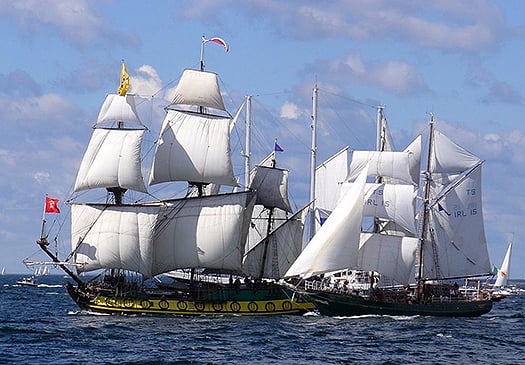
The pain of it. You search out a photo of Shtandart, the remarkable Russian re-creation of an 18th century ship, and you find that Asgard II is sailing beside her
It was while sourcing a photo of Russia's unusual sail training ship Shtandart that the pain of the loss of Asgard II emerged again. It's always there, just below the surface. But it's usually kept in place by the thought that we have to move on, that worse things happened during the grim years of Ireland plunging ever deeper into recession, and that while our beloved ship did indeed sink, no lives were loss and her abandonment was carried out in an exercise of exemplary seamanship.
Yet up came the photo of the Shtandard, and there right beside her was Asgard II, sailing merrily along on what's probably the Baltic, and flying the flag for Ireland with her usual grace and charm. The pain of seeing her doing what she did best really was intense. She is much mourned by everyone who knew her, and particularly those who crewed aboard her. All three of my sons sailed on her as trainees, they all had themselves a great time, and two of them enjoyed it so much they repeated the experience and both became Watch Leaders. It was very gratifying to find afterwards, when you went out into the big wide world and put "Watch Leader Asgard II" on your CV, that it counted for something significant in international seafaring terms.
But as a sailing family with other boat options to fall back on, we didn't feel Asgard II's loss nearly as acutely as those country folk for whom the ship provided the only access to the exciting new world of life on the high seas.

Elaine Byrne vividly recalls how much she appreciated sailing on Asgard II, and how she and her siblings, growing up in the depths of rural Ireland, came to regard the experience of sailing as a trainee on the ship as a "Rite of Passage" through young adulthood
The noted international investigative researcher, academic and journalist Dr Elaine Byrne is from the Carlow/Wicklow border, the oldest of seven children in a farming family where the household income is augmented with a funeral undertaking business attached to a pub in which she still occasionally works. Thus her background is just about as far as it's possible to be from Ireland's limited maritime community. Yet thanks to Asgard II, she was able to take a step into the unknown world of the high seas as a trainee on board, and liked it so much that over the years she spent two months in all aboard Asgard II, graduating through the Watch Leader scheme and sailing in the Tall Ships programmes of races and cruises-in-company
Down in the depths of the country, her new experiences changed the Byrne family's perceptions of seafaring. Elaine Byrne writes:
"Four of my siblings (then) had the opportunity to sail on Asgard II. If it were not for Asgard II, my family would never have had the chance to sail, as we did not live near the sea, nor had the financial resources to do so. The Asgard II played a large role in our family life as it became a Rite of Passage to sail on board her. My two youngest siblings did not sail on the Asgard II because she sank, which they much regret".
She continues: "Apart from the discipline of sailing and the adventure of new experiences and countries, the Asgard brought people of different social class and background together. There are few experiences which can achieve so much during the formative years of young adulthood"
That's it from the heart – and from the heart of the country too, from l'Irlande profonde. So, as the economy starts to pick up again, when you've heard the real meaning of Asgard II expressed so directly then it's time to expect some proper tall ship action for Ireland in the near future. But it's not going to be a simple business. So maybe we should take quick canter through the convoluted story of how Asgard II came into being, in the realization that in its way, creating her successor is proving to be every bit as complex.
As we shall see, the story actually goes back earlier, but we'll begin in 1961 when Erskine Childers's historic 1905-built 51ft ketch Asgard was bought and brought back by the Irish government under some effective public pressure. It was assumed that a vessel of this size – quite a large yacht by the Irish standards of the time – would make an ideal sail training vessel and floating ambassador. It was equally assumed that the Naval Service would be happy to run her. But apart from keen sailing enthusiasts in the Naval Reserve - people like Lt Buddy Thompson and Lt Sean Flood – the Naval Service had enough on its plate with restricted budgets and ageing ships for their primary purpose of fishery patrol.
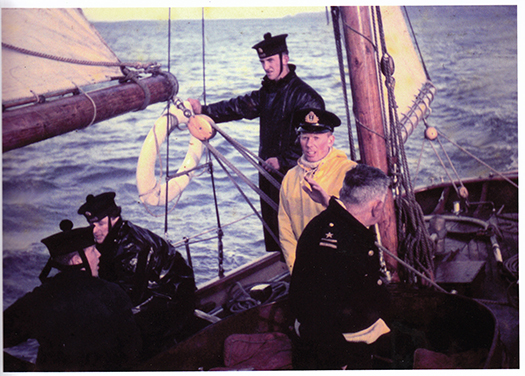
Aboard the first Asgard in 1961 during her brief period in the 1960s as a sail training vessel with the Naval Service – Lt Sean Flood is at the helm
So Asgard was increasingly neglected throughout the 1960s until Charlie Haughey, the new Minister for Finance and the only member of Government with the slightest interest in the sea, was persuaded by the sailing community that Asgard could become a viable sail training ship. In 1968 she was removed from the remit of the Department for Defence into the hands of some rather bewildered officials in the Department for Finance, and a voluntary committee of five experienced sailing people - Coiste an Asgard - was set up to oversee her conversion for sail training use in the boatyard at Malahide, which just happened to be rather less than a million miles from the Minister's constituency.
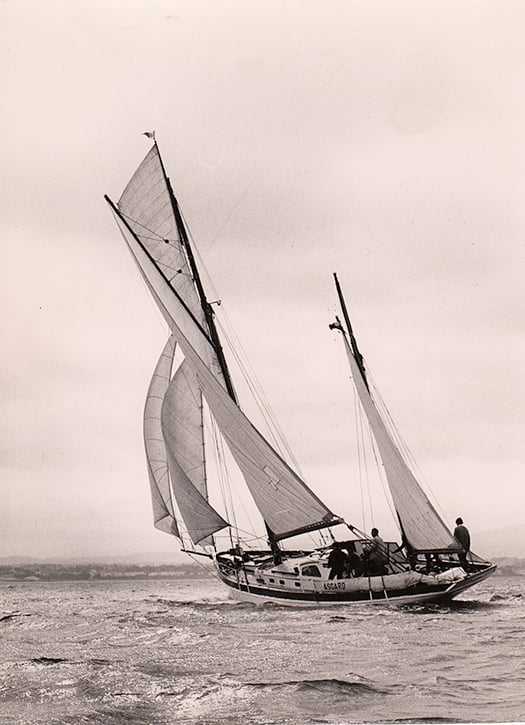
Asgard in her full sail training role in 1970 in Dublin Bay
Asgard was commissioned in her new role in Howth, the scene of her historic gun running in 1914, in the spring of 1969. Under the dedicated command of Captain Eric Healy, the little ship did her very best, but it soon became obvious that her days of active use would be limited by reasons of age, and anyway she was too small to be used for the important sail training vessel roles of providing space to entertain local bigwigs and decision-makers in blazers.
By 1972, the need for a replacement vessel was a matter of growing debate in the sailing community, and during a cruise in West Cork in the summer of 1972, I got talking to Dermot Kennedy of Baltimore out on Cape Clear. Dermot was the man who introduced Glenans to Ireland in 1969, and then he branched out on his own in sail training schools. A man of firm opinions, he reacted with derision to my suggestion that Asgard's replacement should be a modern glassfibre Bermudan ketch, but with enough sails to keep half a dozen trainees busy.
"Nonsense" snorted Dermot. "Ireland needs a real sailing ship, a miniature tall ship maybe, but still a real ship, big enough to carry square rig and have a proper clipper bow and capture the imagination and pride of every Irish person who sets eyes on her. And she should be painted dark green just to show she's the Irish sail training ship, and no doubt about it".
Some time that winter I simply mentioned his suggestions in Afloat magazine, and during the Christmas holidays they were read by Jack Tyrrell at his home in Arklow. During his boyhood, in the school holidays he had sailed with his uncle on the Arklow schooner Lady of Avenel, and it had so shaped his development into the man who was capable of running Ireland's most successful boatyard that he had long dreamed of a modern version of the Lady of Avenel to be Ireland's sail training ship.
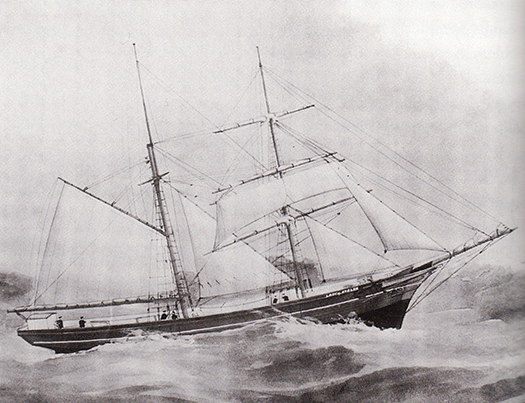
The inspiration – Jack Tyrrell's boyhood experiences aboard Lady of Avenel inspired him to create Ireland's first proper sail training ship
In fact, in 1954 he had sketched out the plans for a 110ft three masted training ship, but Ireland in the 1950s was in the doldrums and the idea got nowhere. Yet the spark was always there, and it was mightily re-kindled by what Dermot Kennedy had said. So at that precise moment, the normal Christmas festivities in the Tyrrell household were over. They'd to continue the celebrations without the head of the family. The great man took himself off down to the little design office in his riverside boatyard, and in clouds of pipe tobacco smoke, he re-drew the lines of the 110ft three master to become an 83ft brigantine, the size reduction meaning that the shop would only need a fulltime crew of five.
Working all hours, he had the proposal drawings finished in time to rejoin his family to see in the New Year. And in the first post after the holiday, we got the drawings at Afloat, and ran them in the February 1973 issue.
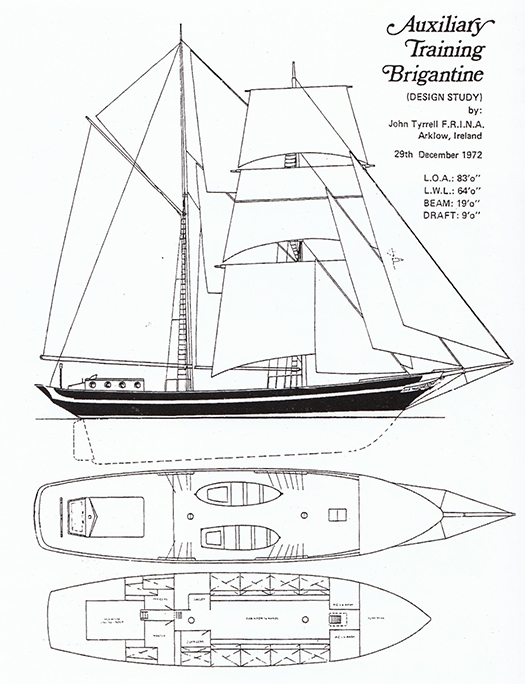
Jack Tyrrell's proposal drawings for the new brigantine, as published in the February 1973 Afloat
In Ireland then as now, most politicians had inscribed in their heads the motto: "There's No Votes In Boats". So after Charlie Haughey had fallen from favour with the Arms Trial of 1970, Coiste an Asgard became an orphan. But 1973 brought a new government, and there was one cabinet minister in it who was proud to proclaim his allegiance to the sea.
Unfortunately for the respectability of the maritime movement in Ireland, our supporters in the higher echelons of politics have often tended to be from the colourful end of the political spectrum, whatever about their placing in the left-right continuum. Thus it was that, at mid-morning on St Patrick's Day 1973, I got an ebullient phone call and an immediate announcement, without the caller saying who he was. "Winkie" he bellowed, "That ship is going to be built. I'll make sure of it. I've just made a ministerial decision".
It emerged that it was our very own new Minister for Defence, Patrick Sarsfield Donegan TD. The enthusiasm for the new ship, engendered by studying Jack Tyrrell's drawings, led to a snap decision which stayed decided, and it all happened in the Department for Defence.
However, it was 1981 by the time the ship was launched, and she looked rather different from Jack Tyrrell's preliminary drawings, though the basic hull shape built in timber was the same sweet lines as originally envisaged, so she was able to sail like a witch. But as for her supporters at Government level, the non-stop cabaret continued. Charlie Haughey had regained power, and by 1981 he was Taoiseach. It was he who had seen to it that the Department of Defence continued to look after the Asgard II project with support from another sailing TD who might not have seen eye–to-eye with him on other matters, Bobby Molloy of Galway.
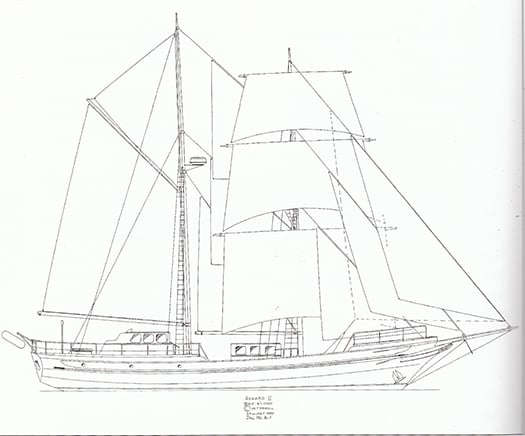
Asgard II in her finished form
So on a March day in 1981, almost exactly twelve years after he'd commissioned the original Asgard in her new role as a sail training vessel, Charlie Haughey took it upon himself to christen the new Asgard II in Arklow basin. And the champagne bottle refused to break. Five or six time he tried, but with no success.
Showing considerable grace under pressure and observed by a large crowd, he quietly took his time undoing all the ribbons and paraphernalia on the big bottle. Then he marched with it up to the new flagship's stem, and hit it a mighty double-handed wallop. The bottle exploded that time, with no mistake. And apart from the usual Haughey growl to those nearby about the idiocy of whoever forgot to score the champagne bottle beforehand, it was all done with the best of humour.
For most of her subsequent career, there's no doubt Asgard was a lucky and very successful vessel. Yet when her demise came, you couldn't help but think of the old notion that if the champagne bottle doesn't break first time, then she'll ultimately be an unlucky ship.
But there are more prosaic explanations. With a limited budget and every penny being scrutinized, Jack Tyrrell and his men had to build Asgard II in fishing boat style, which is fine within its proper time span, but that time span is really only twenty years, maybe thirty if the ship gets extra care. But with her fishing boat hull carrying a demanding brigantine rig, although she always looked immaculate, Asgard II was starting to show her age in the stress areas.
By 2005 there was serious talk about the need to plan for a replacement. When her skipper Colm Newport was told to renew her rig as the original spars were clearly well past it, he meticulously searched the best timber yards at home and abroad and when she got her new rig – it was 2006 or thereabouts – I wrote an only slightly tongue-in-cheek article suggesting that now was the time to replace her old tired wooden hull with a new steel one to the same Jack Tyrrell lines, but utilising the excellent new rig and as many of the fixtures and fittings as were still in good order from the original ship.
To say the response was negative is understating the case. People's attachment to Asgard could only imagine a wooden ship. It was the end of any meaningful debate. So things drifted on, with each new government seemingly even less interested in maritime matters generally, and sail training in particular, than the one before.
In September 2008, Asgard started taking in water while on passage with a crew of trainees towards La Rochelle for a maritime festival following which - while still in La Rochelle – it was planned that she would be lifted out for a thorough three week survey and maintenance programme.

Asgard's accommodation worked superbly whether at sea or in port. But the fact that so much was packed into a relatively small hull meant that some areas were almost inaccessible for proper inspection
It might have been the saving of her. But it was not to be. It's said that it was a failed seacock which caused the catastrophic ingress of water. She was a very crowded little ship, she packed a lot into her 84ft, so some hull fittings were less accessible internally than they would be in a more modern vessel, and may have deteriorated to a dangerous level. But if, as some would propose, she hit something in the water which caused a plank to start, then the fact that nobody aboard was aware of any impact suggests that the time for a major overhaul, and preferably a hull replacement, was long overdue.
The moment Asgard II sank, she ceased to have any future as a sail training vessel, and there was no real official interest in her salvage. You simply cannot take other people's children to sea on a salvaged vessel of doubtful seaworthiness. And as it happens, the sinking came at exactly the time the Irish economy fell of a cliff. So although after an enquiry the Government accepted a €3.8 million insurance settlement, in the end, despite assurances to the contrary, it disappeared into the bottomless pit which was the national debt, and within a year Coiste an Asgard was wound up with its records and few resources incorporated into a new entity, Sail Training Ireland.
The plot takes a further macabre twist in that, shortly after the loss of Asgard II, the Northern Ireland Sailing Training ketch was also lost after hitting a rock on the Antrim coast. From having two popular and well-used sail training vessels in the middle of 2008, within a year Ireland had no official sail training vessels at all.
Yet though the flame had been largely subdued, there were those who have kept the faith, and gradually the sail training movement is being rebuilt. Sail Training Ireland is the frontline representative for around five different organisations, being the official affiliate of Sail Training International, and it has a busy programme of placing trainees in ships which operate at an international level, in which the Dutch are supreme.
In Ireland at the moment, the only sail training "ship" is the schooner Spirit of Oysterhaven, run by Oliver Hart and his team from their adventure centre near Kinsale. In fact, Spirit – you can read about her in Theo Dorgan's evocative book Sailing For Home (Penguin Ireland 2004) – really is punching way above her weight in representing Ireland in a style reminiscent of both the Asgards.
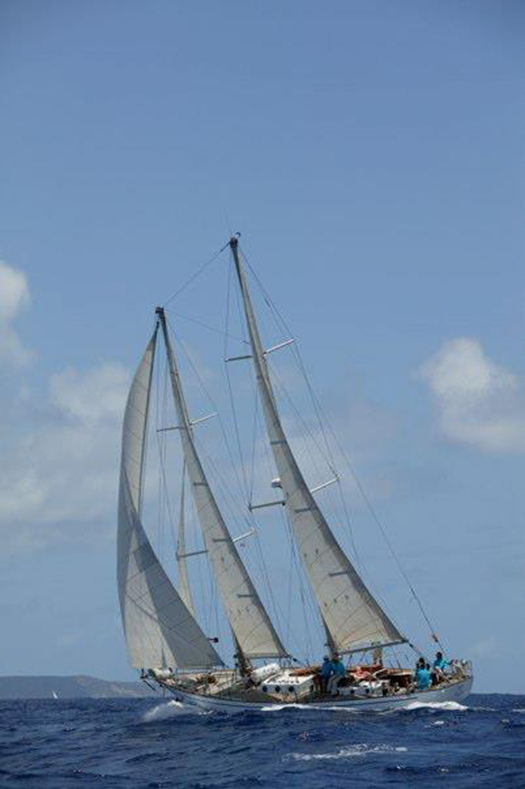
Spirit of Oysterhaven has been doing great work in keeping sail training alive in Ireland
But having the ship is one thing, paying the fees for the trainees to be aboard is something else, and sail training bursaries are one of the key areas of expansion in current maritime development in Ireland. There was an unusual turn to this in 2014 when somebody came up with the bright idea of using Irish Cruising Club funds (which are generated by the surplus from the voluntary production of the club's Sailing Directions) to provide bursaries for youngsters to take part in last summer's ICC 85th Anniversary Cruise-in-Company along the southwestern seaboard on Spirit of Oysterhaven.
The idea worked brilliantly, and this concept of neatly-tailored sail training bursaries is clearly one which can be usefully developed. But still and all, while it's great that young Irish people are being assisted in getting berths aboard charismatic vessels like Europa, the feeling that we should have our own proper sail training ship again is gradually gaining traction, and this is where the Atlantic Youth Trust comes in.
The AYT had its inaugural general meeting in Belfast as recently as the end of September 2014, so it may not yet have come up on your radar. But as it has emerged out of the Pride of Ireland Trust which in turn emerged from the Pride of Galway Trust, you'll have guessed that Enda O'Coineen and John Killeen are much involved, and they've roped in some seriously heavy hitters from both sides of the border, either as Board Members or backers, and sometimes as both.
The cross-border element is central to the concept of building a 40 metre three-masted barquentine, a size which would put her among the glamour girls in Class A, and could carry a decidedly large complement of 40 trainees, even if you're inevitably talking of stratospheric professional crewing costs.
However, by going straight in at top government level on both sides of the border, the AYT team are finding that they're pushing at a door which wants to open, particularly after the new Stormont House agreement was reached in the last days of 2014 to bring a more enthusiastic approach both to cross-community initiatives in the north, and cross border co-operation generally.
Who knows, but if they can succeed in getting cross-community initiatives working in Northern Ireland, then they may even be able to swing some sort of genuine Dublin-Cork shared enthusiasm in the Republic, for I've long thought that one of the factors in holding back many maritime initiatives in Ireland is that, while Dublin may be the political capital, Cork is quietly confident it's the real maritime capital, and does its own thing.
Be that as it may, the AYT have done serious studies, and their conclusion is the best scheme to learn from is the Spirit of Adventure programme in New Zealand. This is where the feeling of going back to the future arises, for in looking at photos of their ship Spirit of New Zealand, there's no escaping the thought that you're looking at Jack Tyrrell's concept ship of 1954 brought superbly to life.
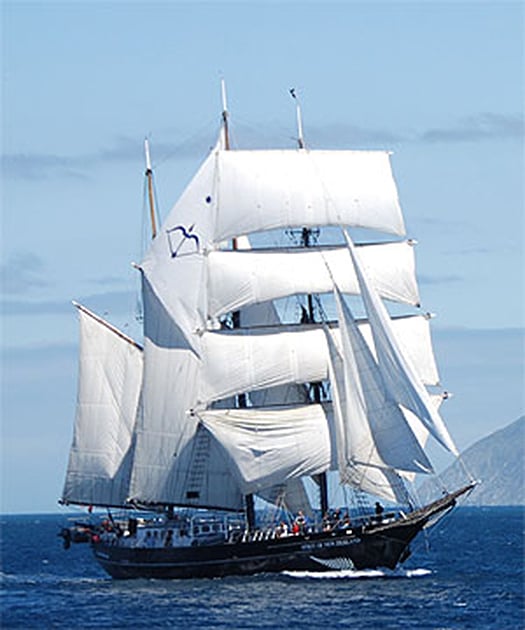
Spirit of New Zealand

Spirit of New Zealand almost seems like a vision of 1954 brought to life...

.....and that vision is Jack Tyrrell's 1954 concept for a 110ft sail training ship
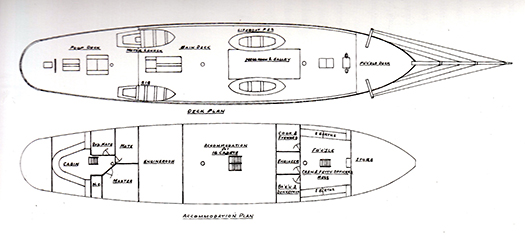
The 1954 accommodation drawings for the 110ft ship hark back to a more rugged age. Imagine the difficulties the ship's cook would face trying to get hot food from his galley on deck amidships all the way back to the officers in their mess down aft
We needn't necessarily agree with all the AYT's basic thinking For instance, they assert that Ireland is like New Zealand is being an isolated smallish island. It depends what you mean by "isolated". Those early sail training pioneers, the Vikings, certainly didn't think of Ireland as isolated. They thought it was central to the entire business of sailing up and down Europe's coastline.
Thus any all-Ireland sail training vessel would be expected to be away abroad at least as much as she'd be at home, whereas Spirit of New Zealand is usually home – the season of 2013-2014 was the first time she'd been to Australia since 1988, when she was in the fleet with Asgard II for the First Feet celebrations.
In New Zealand, she's a sort of floating adventure centre, and a large tender often accompanies her to take the trainees to the nearest landing place for shoreside adventures, for it's quite a challenge keeping 40 energetic young people fully occupied.
In Europe, that's where the sail training races come in. Time was when the racing aspect was down-played. But there's nothing like a good race to bring a mutinous crew together, and the recently-published mega-book about the world's sail training vessels, Tall Ships Today by Nigel Rowe of Sail Training International, quite rightly devotes significant space to everything to do with the racing.
Thus if we do get a new sail training ship for Ireland, she'll have to sail well and fast. That was Asgard II's greatest virtue. For there is nothing more dispiriting for troubled young folk than to find themselves shackled to the woofer of the fleet. Yet you'd be pleasantly surprised by how previously disengaged youngster can become actively and enthusiastically involved when they find that they're being transformed from scared and seasick kids into members of a winning crew.
So now, the 64 thousand dollar question. The cost. It's rather more than 64 thousand. AYT reckon they'll have to come up with a final capital expenditure of €15 million to build the ship and get her into full commission with proper crewing and shoreside administration arrangements in place. But after that – and here's the kernel of the whole concept – they reckon that the running costs will come out of existing government expenditure already in place and used every year for education, youth training, sporting facilities, social development and so forth.
So their pitch is that if the governments north and south come up with funding to support substantial donations already proposed for AYT by various benevolent national and international bodies, then once the ship is in being, she will generate her own income in the same way as vessels like Europa and Morgen Stern are already doing in mainland Europe.
And it's to the heart of mainland Europe that they'll be looking for design and contruction, as it's the Dykstra partnership which will be overseeing the design, and their ship-build associate company Damen will likely do the construction work, though one idea being floated is that Damen might provide a flatpack kit for the vessel to be built in steel in Ireland.
Those of us who dream of Asgard II being built anew will find all this a bit challenging to take on board. My own hopes, for instance, would still be to build Asgard II again to Jack Tyrrell's lines, but with the hull constructed in aluminium. It would be expensive as it would need to be double-skin below the waterline, but the ship's size would be very manageable with a professional crew of just five, while she'd sail like a dream And proper top-class marine grade aluminium seems to last for ever, as naval architect Gerry Dijkstra (his surname is slightly different from that of the partnership) himself shows with his remarkable cruises with his own-designed alloy 54-footer Bestevaer.
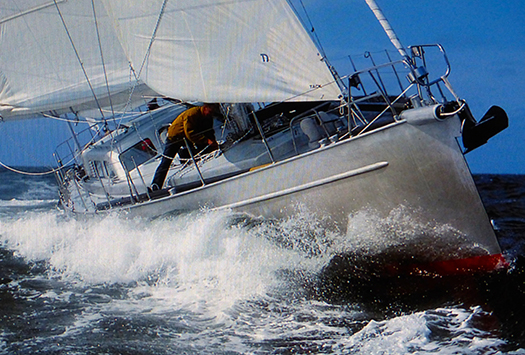
A man who knows what he's doing. This is Gerry Dijkstra's own extensively-cruised alloy-built 54 footer Bestevaer. The name translates not as "Best ever", but either as "best father" or "best seafarer", and was the name of affection given to the great Admiral de Ruyter by his loyal crews
Whatever, the good news is that things are on the move, and we wish them well, all those who have kept the Irish sail training flame alive through some appalling setbacks. Now, it really is the time to move forward. And if we do get a new ship, why not call her the Jack Tyrrell? He, of all people, was the one who kept the faith and the flame alive.
- Tall ship
- Belfast
- Jack Tyrell
- Kristiansand
- Aalesund
- Titanic
- maritime
- Class A
- square riggers
- George Stage
- Alexander Von Humboldt
- Christian Radich
- Sorlandet
- Shtandart
- Brigantine
- Asgard II
- Elaine Byrne
- Erskine Childers
- Sean Flood
- Naval
- Afloat magazine
- boatyard
- sail training ship
- Coiste an Asgard
- Charlie Haughey
- Colm Newport
- Irish Cruising Club
- Spirit of Oysterhaven
- Enda O'Coineen
- John Killeen
- Dykstra
RNLI Honours Volunteers, Celebrates 190 Years In Belfast
#RNLI - The RNLI brought two of its all-weather lifeboats into Belfast on Wednesday 17 June for the charity’s 190th anniversary of saving lives at sea.
To mark the milestone, the RNLI hosted an awareness day in the Titanic Quarter with a full display of their life saving equipment including the Severn and Trent class all-weather lifeboats, RNLI beach lifeguards and their vehicles and the Flood Rescue kit.
The lifeboats were crewed by volunteer lifeboat crew members from Northern Ireland lifeboat stations.
First Minister Peter Robinson visited the event to meet with the RNLI lifeguards and volunteer lifeboat crew, view the lifesaving equipment and learn about the work of the charity in Northern Ireland.
The First Minister also boarded the Severn class lifeboat for a short trip around Belfast Harbour.
"We wanted to bring a little bit of the RNLI to Belfast city," said RNLI divisional operations manager Gareth Morrison. "There is huge awareness of the work of the charity out on coast and at the inland stations where we are present but we wanted to bring our volunteers and equipment into the city for people to see.
"With the awards taking place in the Titanic centre it was a fitting way to mark 190 years saving lives."
The day culminated with the RNLI Annual Presentation of Awards for Northern Ireland fundraising and operational volunteers, which this year was held at Titanic Belfast.
RNLI volunteers and supporters from across Northern Ireland were recognised for their dedication and commitment to raising funds and awareness for the lifesaving charity and for playing a pivotal role in ensuring lifeboat crews and lifeguards can continue to save lives at sea.
Guest of honour and presenting the awards was RNLI chairman Charles Hunter-Pease, who was attending his first awards ceremony in Northern Ireland since taking up his role with the charity last year.
The awards included five gold badges, three silver badges, six bronze badges, 14 inscribed statuettes, six regional supporter awards and six certificates of thanks.
Among the gold badge recipients was Rita Jarvis from the Bangor branch, who was described as an outstanding volunteer who had worked tirelessly for over 20 years for Bangor RNLI.
Hubert Annett from Kilkeel was acknowledged as one of the station's characters, who had performed various roles including that of deputy launching authority over the last 20 years.
Guests heard how Kay Magee joined Maghera RNLI over 30 years ago and remained a driving force at the inland branch throughout.
Gavin Weatherall from Newtownabbey RNLI was acknowledged for his devotion to fundraising for over 25 years with roles including that of treasurer and more recently secretary of the branch.
Patricia Ritchie, the fifth of the gold badge awardees, was described as a highly devoted secretary at Portadown where she has worked tirelessly for more than 23 years.
Two gold badge recipients collected their awards at the RNLI’s annual presentation of awards in London last month. These included Lennie Lawson, deputy launching uthority at Portaferry RNLI and Patricia Crossley, chairman of the Ballymoney fundraising branch. Merwyn Hanna MBE from Kilkeel Fundraising Branch was made an Honorory Life Governor.
Praising the awardees, Hunter-Pease said: "It all starts with the people who give their time, their donation and their expertise.
"Over the decades, as we have expanded our service and developed new craft and facilities; our volunteers, fundraisers and supporters have become more important than ever.
"Without them there is no lifeboat station, no lifeguard unit, no flood rescue team, and no coastal safety work preventing tragedies."
Coast Guard Finds Child at Base of Cliff
#coastguard – Belfast Coastguard coordinated the search yesterday evening for a child who was missing near cliffs close to the Silvercliff Caravan Park at Ballycastle.
The Ballycastle and Coleraine Coastguard Rescue Teams, a Police helicopter, the rescue helicopter from RAF Prestwick and the Portrush and Red Bay RNLI lifeboats all searched for the missing child after Belfast Coastguard received reports that the child was missing.
The child was found at the base of the cliffs and has been taken by the RAF helicopter to Coleraine Hospital.
RNLI add:
RNLI lifeboats from Portrush and Red Bay involved in search for child in Ballycastle
Two volunteer lifeboat crews were involved last night in the search for a child who was missing near cliffs at Ballycastle, County Antrim.
The RNLI lifeboats from Portrush and Red Bay were launched at 7.20pm last night (15 June) and once on scene commenced an intensive search along the coast and in the Ballycastle area.
The child was found at the base of the cliffs and was taken by the RAF helicopter to Coleraine Hospital.
Sadly it has been announced that the child has died and the RNLI lifeboat volunteers at both Red Bay and Portrush wish to offer their deepest sympathies to the family.
Lagan Head Off But Cork Head May Go Ahead
#ROWING: The Lagan Head of the River Races, scheduled for this Saturday, have been cancelled. The organisers, Belfast Boat Club, say that the safety and wellbeing of competitors and organisers was their primary focus. Because of a combination of increased flow on the river, and the forecast wind speed, wind direction, and temperature they would be unable to guarantee the safe marshalling of crews for a head of the river race. They made the decision in order that crews can make other arrangements for the weekend.
However, the organisers of Cork Head of the River, which is also set for Saturday, hope to hold the event. Any decision on cancellation will be announced tomorrow (Friday).
Scotland Takes Issue With Belfast Coastguard Staffing Concerns
#Coastguard - Last month's Belfast Coastguard understaffing concerns have been echoed across the North Channel in Western Scotland, with the SNP adding its voice to the chorus of disapproval.
As Glasgow's Evening Times reports, Belfast's repeated staffing issues - the station was manned below risk-assessed levels on eight separate occasions - compounded problems already identified at Aberdeen, which was understaffed for more than half of all shifts in December.
Both stations are charged with protecting the entirely of the mainland Scottish coastline, on top of Belfast's duties for the whole of Northern Ireland.
The SNP's Stuart McMillan has cited both station's staffing records as evidence that the decision to close the Clyde coastguard station in Greenock, northwest of Glasgow, was ill-advised.
These concerns come as Ireland faces its own coastguard consultation efforts that threaten to undermine "30 years of progress in marine safety".
The Evening Times has more on the story HERE.
Belfast Coastguard Short-Staffing Raises Concerns
#Coastguard - Belfast Coastguard was staffed "at below risk assessed levels" on eight separate occasions last month, as the Belfast Telegraph reports.
The upsetting news was revealed by Britain's Transport Minister Stephen Hammon in response to a parliamentary question on the status of Northern Ireland's only full-time maritime search and rescue control centre - which also has responsibility for much of the east coast of Scotland after the closure of Clyde Coastguard near Glasgow just over a year ago.
The Maritime and Coastguard Agency (MCA) confirmed that Belfast received support from other coastguard centres - such as Stornoway - when its staff levels dipped below requirements.
Meanwhile, coastguard staff have until 10 January 2014 to either re-apply for their jobs or take redundancy under the British Government's streamlining of the national coastguard network.
The Belfast Telegraph has more on the story HERE.
Fine Indoor Rowing Show by Bann Athlete Erin Barry
#BelfastIndoorRowing: Erin Barry, a junior 16 athlete, set an excellent time of seven minutes 2.1 seconds for the 2,000 metres at the Belfast Indoor Rowing Event today. Barry, from the Bann club in Coleraine, was over 30 seconds faster than her nearest rival. One of the top performers from the Irish Indoor Championships last week, Sam McKeown from Portadown, was entered but did not take part. The event served as part of the Ireland trialling system and a round of the British University indoor series.
| UIR 2013 Nov 30 |
|---|
| RESULTS INFO |
| 2000m 1005 R1 W U16 Drag 120 |
| Best from Limerick WU16 7:22.7 MANUAL SPLITS eg 00:03:55.4 |
| LANE CODE RACE NAME 500 1000 1500 2000 |
| 1 1 Barry BANN W U16 07:02.1 |
| 2 2 DeSay NEPTUNE W U16 DNS |
| 3 3 Clarke PORTORA W U16 07:39.2 |
| 4 4 Shirlow BANN W U16 07:36.0 |
| 5 5 McGrath CARLOW W U16 07:53.8 |
| 6 6 Walker P'DOWN W U16 08:21.9 |
| 7 0 7 |
| 8 0 8 |
| 9 0 9 |
| 10 0 10 |
| 11 0 11 |
| 12 0 12 |
| 2000m 1025 R2 W U16_Olwt Drag 120 LWW 125 |
| Best from Limerick WOL 7:18.1 MANUAL SPLITS |
| LANE CODE RACE NAME 500 1000 1500 2000 |
| 1 1 |
| 2 2 |
| 3 3 |
| 4 4 |
| 5 8 McCann P'DOWN W U16 DNF |
| 6 2 DeSay NEPTUNE W U16 08:40.9 |
| 7 7 mullan BANN W U16 07:45.5 |
| 8 8 |
| 9 9 chestnutt BANN W U16 07:54.5 |
| 10 10 scott BANN W U16 07:53.8 |
| 11 11 Watson QULBC W OLwt 08:15.5 |
| 12 12 Cunningham QULBC W OLwt 00:05.6 |
| 2000m 1045 R3 M U16 Drag 130 |
| Best from Limerick 6:32.6 MANUAL SPLITS |
| LANE CODE RACE NAME 500 1000 1500 2000 |
| 1 13 MITCHELL BANN M U16 06:35.9 |
| 2 14 DAVIDSON BANN M U16 06:55.9 |
| 3 15 PARISH BANN M U16 06:48.8 |
| 4 16 CHRISTIE BANN M U16 06:56.5 |
| 5 0 5 |
| 6 0 6 |
| 7 0 7 |
| 8 0 8 |
| 9 0 9 |
| 10 0 10 |
| 11 0 11 |
| 12 0 12 |
| UIR 2013 Nov 30 |
| 1000m 1105 R4 W U15_M50+ Drag free |
| Best from Limerick 3:45.8 MANUAL SPLITS |
| LANE CODE RACE NAME 500 1000 |
| 1 17 Coulter BELFAST RC W U15 04:09.5 |
| 2 18 Taylor BELFAST RC W U15 04:00.3 |
| 3 19 McIntyre LAGAN SC W U15 04:04.4 |
| 4 20 Hobson BELFAST RC W U15 04:02.8 |
| 5 21 White BELFAST RC W U15 DNF |
| 6 22 Booth STRANMILLIS M 50+ DNS |
| 7 0 7 |
| 8 0 8 |
| 9 0 9 |
| 10 0 10 |
| 11 0 11 |
| 12 0 12 |
| 2000m 1145 R5a W U18 Comb Drag 120 |
| Best from Limerick 7:15.2 MANUAL SPLITS |
| LANE CODE RACE NAME 500 1000 1500 2000 |
| 1 23 English BBC-TALENT W U18 07:17.9 |
| 2 24 Connolly NEPTUNE W U18 07:37.9 |
| 3 25 morelli BANN W U18 07:49.4 |
| 4 26 Turner BBC-TALENT W U18 07:36.7 |
| 5 27 Coleman NEPTUNE W U18 07:49.2 |
| 6 28 Martin P'DOWN W U18 08:46.3 |
| 7 29 wray BANN W U18 07:40.2 |
| 8 30 Glover PORTORA W U18 07:45.9 |
| 9 31 Blundell BBC-TALENT W U18 08:01.7 |
| 10 32 Byrne NEPTUNE W U18 07:46.3 |
| 11 33 Flack P'DOWN W U18 08:40.5 |
| 12 35 Smylie P'DOWN W U18 08:09.2 |
| 2000m 1205 R7 W OLwt_U23Lwt Drag 120 BUCS 125 lanes 3,4,5 |
| Best from Limerick WU23L 7:25.3 MANUAL SPLITS |
| LANE CODE RACE NAME 500 1000 1500 2000 |
| 1 36 Quinn BBC-TALENT W OLwt 07:18.1 |
| 2 37 Cameron BBC-TALENT W OLwt 07:33.5 |
| 3 38 Elliot QULBC W OLwt 08:11.8 |
| 4 39 Flynn QULBC W OLwt 08:44.7 |
| 5 40 Todd QULBC W OLwt 08:11.1 |
| 6 41 Morris DULBC W U23Lwt 07:27.2 |
| 7 42 Maguire QULBC W U23Lwt DNS |
| 8 0 8 |
| 9 0 9 |
| 10 0 10 |
| 11 0 11 |
| 12 0 12 |
| UIR 2013 Nov 30 |
| 2000m R8 M U18 Drag 130 |
| Best from Limerick 6:25.2 MANUAL SPLITS |
| LANE CODE RACE NAME 500 1000 1500 2000 |
| 1 43 Meenagh CAI M U18 07:16.8 |
| 2 44 Murray BBC-TALENT M U18 06:33.6 |
| 3 45 Murray PORTORA M U18 06:38.2 |
| 4 46 Curran CARLOW M U18 DNS |
| 5 47 Carroll COMMERCIAL M U18 07:08.2 |
| 6 48 McKillen QUBBC M U18 06:19.7 |
| 7 49 Chambers P'DOWN M U18 07:33.6 |
| 8 50 Doyle NEPTUNE M U18 DNS |
| 9 51 Mullan CAI M U18 06:57.0 |
| 10 52 Rix PORTORA M U18 06:31.3 |
| 11 53 Nolan CARLOW M U18 DNS |
| 12 0 12 |
| 2000m 1245 R9 M U18 Drag 130 |
| Best from Limerick 6:25.2 MANUAL SPLITS |
| LANE CODE RACE NAME 500 1000 1500 2000 |
| 1 54 Keenan COMMERCIAL M U18 06:49.1 |
| 2 55 Ferguson P'DOWN M U18 07:45.7 |
| 3 56 Simpson CAI M U18 07:17.9 |
| 4 57 Taggart CAI M U18 DNS |
| 5 58 Dunne COMMERCIAL M U18 06:58.0 |
| 6 59 Kerr P'DOWN M U18 08:07.0 |
| 7 60 McCaughtry BELFAST RC M U18 07:24.4 |
| 8 61 Bassett P'DOWN M U18 07:40.8 |
| 9 62 Kennedy CAI M U18 06:48.3 |
| 10 0 10 |
| 11 0 11 |
| 12 0 12 |
| 1000m 1305 R10 W Beginner Drag 130 |
| MANUAL SPLITS |
| LANE CODE RACE NAME 500 1000 |
| 1 63 Murdoch QULBC begW 04:18.2 |
| 2 64 Chapman QULBC begW 03:46.0 |
| 3 65 McGaughey QULBC begW 04:35.3 |
| 4 66 Laverty QULBC begW 04:27.8 |
| 5 67 Mullen QULBC begW 04:04.4 |
| 6 68 Whittaker QULBC begW DNS |
| 7 69 Hinds QULBC begW 04:31.4 |
| 8 70 Fordwar QULBC begW 04:19.4 |
| 9 71 Burnside QULBC begW 04:12.1 |
| 10 72 Victoria QULBC begW 04:17.9 |
| 11 73 Kelly QULBC begW 04:03.0 |
| 12 74 McBrien QULBC begW 04:08.6 |
| UIR 2013 Nov 30 |
| 1000m R11 W Beginner Drag 130 |
| MANUAL SPLITS |
| LANE CODE RACE NAME 500 1000 |
| 1 75 Fisher QULBC begW 04:13.7 |
| 2 76 Goodwin QULBC begW 04:28.8 |
| 3 77 Kelso QULBC begW 04:03.0 |
| 4 78 Copeland QULBC begW 04:33.3 |
| 5 79 Niamh QULBC begW 04:06.5 |
| 6 80 McI QULBC begW 04:10.8 |
| 7 81 Simpson QULBC begW 04:53.9 |
| 8 82 Kelly QULBC begW 04:05.7 |
| 9 83 Willis QULBC begW 04:06.5 |
| 10 84 Baxter QULBC begW DNS |
| 11 85 Mary Claire QULBC begW DNS |
| 12 86 Davis QULBC begW DNS |
| 2000m 1335 R12 W O Drag 130 BUCS |
| Best from Limerick 6:53.2 MANUAL SPLITS |
| LANE CODE RACE NAME 500 1000 1500 2000 |
| 1 87 McPherson QULBC W O 08:16.1 |
| 2 88 Taylor QULBC W O 07:51.8 |
| 3 89 Maguire QULBC W O 07:49.2 |
| 4 90 Thornton QULBC W O 07:50.6 |
| 5 91 McGookin QULBC W O 07:47.7 |
| 6 92 Bossmann QULBC W O DNS |
| 7 93 Abbott QULBC W O 08:25.1 |
| 8 94 Brown QULBC W O 08:01.0 |
| 9 95 Doran QULBC W O DNS |
| 10 96 Alicia QULBC W O 08:15.8 |
| 11 97 Holmes QULBC W O 08:20.1 |
| 12 0 12 |
| 2000m 1355 R13a M 23Lwt_OL_MO_M23 Drag 130 (BUCS) |
| Best from Limerick 23L 6:28.3 OL 6:19.1 MANUAL SPLITS |
| LANE CODE RACE NAME 500 1000 1500 2000 |
| 1 98 mcafee BANN M U23Lwt 06:30.9 |
| 2 99 Hetherington ANGLIA RUSK M U23Lwt 06:42.4 |
| 3 100 McCann QUBBC M OLwt 06:46.2 |
| 4 101 McMullan QUBBC M OLwt 06:44.6 |
| 5 |
| 6 103 Armstrong QUBBC M OLwt 06:39.5 |
| 7 104 Evans QUBBC M OLwt 07:14.5 |
| 8 |
| 9 106 Moneypenney P'DOWN M O 06:51.4 |
| 10 109 Moran QUBBC M O 07:00.4 |
| 11 111 Magill QUBBC M U23 06:36.1 |
| 12 102 Abel QUBBC M OLwt 07:07.6 |
| UIR 2013 Nov 30 |
| 1000m 1435 R15 M Beginner Drag 138 |
| MANUAL SPLITS |
| LANE CODE RACE NAME 500 1000 |
| 1 113 Gallagher QUBBC begM 03:22.2 |
| 2 114 Gray QUBBC begM DNS |
| 3 115 McClure QUBBC begM DNS |
| 4 116 McCormack QUBBC begM 03:24.5 |
| 5 117 Murray QUBBC begM 03:15.8 |
| 6 118 Rice QUBBC begM 05:21.6 |
| 7 119 Leonard QUBBC begM 03:31.1 |
| 8 120 Sloan QUBBC begM DNS |
| 9 121 Troughton QUBBC begM 03:34.5 |
| 10 122 Connolly QUBBC begM DNS |
| 11 123 Doherty QUBBC begM DNS |
| 12 124 Stevenson QUBBC begM DNS |
| 1000m 1450 R16 M Beginner Drag 138 |
| MANUAL SPLITS |
| LANE CODE RACE NAME 500 1000 |
| 1 125 Breslin QUBBC begM 03:37.6 |
| 2 126 Herron QUBBC begM 03:29.2 |
| 3 127 McClure QUBBC begM 03:45.2 |
| 4 128 Erskine QUBBC begM 03:19.4 |
| 5 129 Smith QUBBC begM 03:38.1 |
| 6 130 Sets QUBBC begM 03:19.4 |
| 7 131 Duffin QUBBC begM 03:50.1 |
| 8 132 Thompson QUBBC begM 03:38.3 |
| 9 133 Henry QUBBC begM 04:03.7 |
| 10 134 Vincent QUBBC begM 03:15.9 |
| 11 135 White QUBBC begM 03:21.2 |
| 12 136 Allen QUBBC begM 03:49.8 |
| 1000m 1520 R18 M Beginner Drag 138 |
| MANUAL SPLITS |
| LANE CODE RACE NAME 500 1000 |
| 1 147 Graham QUBBC begM 03:16.6 |
| 2 148 McConnell QUBBC begM 03:57.7 |
| 3 149 Doyle QUBBC begM 03:07.7 |
| 4 150 Patton QUBBC begM 03:09.9 |
| 5 151 Lisowski QUBBC begM 03:19.3 |
| 6 152 Beatty QUBBC begM 03:23.2 |
| 7 153 Williamson QUBBC begM 03:23.8 |
| 8 154 J Kelly QUBBC begM 03:16.6 |
| 9 155 Brennan QUBBC begM 03:59.9 |
| 10 156 Machado QUBBC begM 03:37.4 |
| 11 0 Ruddy QUBBC begM 03:48.9 |
| 12 0 12 |
Ireland & Northern Ireland To Become Centre Of Excellence For Marine ICT
#MarineScience - The SmartOcean Forum taking place at Titanic Belfast over the next two days (5-6 November) aims to establish Northern Ireland and Ireland as leaders in the development of ICT products and services for global marine sectors.
The Invest Northern Ireland-sponsored event will focus on developing high-tech products and services for traditional sectors such as fisheries, aquaculture, transport and security and emerging sectors such as renewable ocean energy and environmental monitoring, and ocean observation.
The forum will give insights on emerging markets, policy and opportunities for innovation associated with the launch of Horizon 2020 in 2014 and will focus on the challenges for SMEs to drive innovation in an emerging marine technology sector. It will also explore initiatives and investment for capacity build to develop a marine ICT sector here that can derive economic benefits from our ocean.
There are a number of opportunities emerging through local and international initiatives and we need to be in a position to work with Atlantic partners in the sustainable development of our ocean resource.
NI Minister of Enterprise Trade and Investment, Arlene Foster, said: “Today’s SmartOcean forum follows our recent Northern Ireland Investment Conference which successfully highlighted to an international business audience the strengths that we have to offer.
"Programmes like SmartOcean allow us to continue building on our traditional strengths of engineering excellence and our long history of innovation, whilst developing new skill sets to meet the needs of the fast changing world of technology and renewable energy, and with it bringing real opportunities for economic growth and development.
Minister Foster added that her department "has been leading on the development of the Northern Ireland Innovation Strategy. Fundamental to this strategy is the concept of open innovation and collaboration. The rapid rise of innovation in technology and the emerging opportunities coming from the marine sector offers considerable scope and opportunities for those companies who are willing to finding new innovative ways of working and developing.”
Meanwhile, Maire Geoghegan Quinn, EU Commissioner for Research & Innovation, highlighted the "strong convergences between SmartOcean and our plans for ocean-related research and innovation in Horizon 2020, the EU’s new research and innovation programme.
"By bringing together the best ICT experts, marine technology providers and marine scientists in Ireland, the SmartOcean cluster has created the right innovation environment to harvest the potential of the blue economy. Research and innovation are essential to unlock the potential of marine energy and the marine bio-economy and to use deep-sea resources in a sustainable way.”
The SmartOcean Forum aims to build on the Atlantic Ocean Research Alliance between the EU, United States and Canada, launched at the Marine Institute in Galway last May.
A goal of the alliance is to develop a transatlantic ocean observation system which will increase our understanding of the oceans and promote ocean innovation through improved access to a broad range of ocean data.
Marine Institute chief executive Dr Peter Heffernan, who opened the forum, said: “Our ocean territory is our greatest natural resource and the need to understand and manage it has never been greater.
"We have a huge opportunity to lead the way in marine ICT to support the sustainable development of our ocean resource. And we are steadily working towards the targets set out in [the Irish] Government’s Harnessing Our Ocean Wealth - An Integrated Marine Plan for Ireland to ensure that our ocean wealth will be a key component of our economic recovery and sustainable growth, generating social, cultural and economic benefits for all citizens."
Other speakers at the event include Dr Gilles Ollier, head of sector for earth observation and director general for research and innovation with the European Commission; Karen Skinner of the Atlantic Canada Opportunities Agency; and Suzanne Kelly, deputy director of the US Integrated Ocean Observing System programme with the NOAA; while representatives from Microsoft, SAP, Cathx Ocean and Magnet Networks will give keynotes.





























